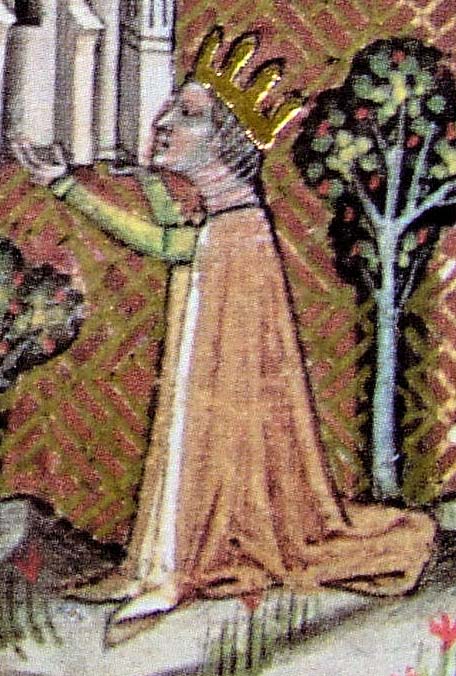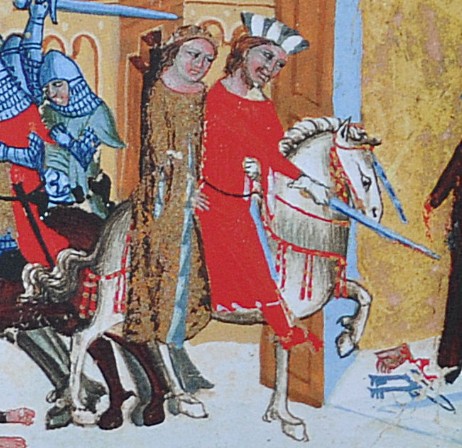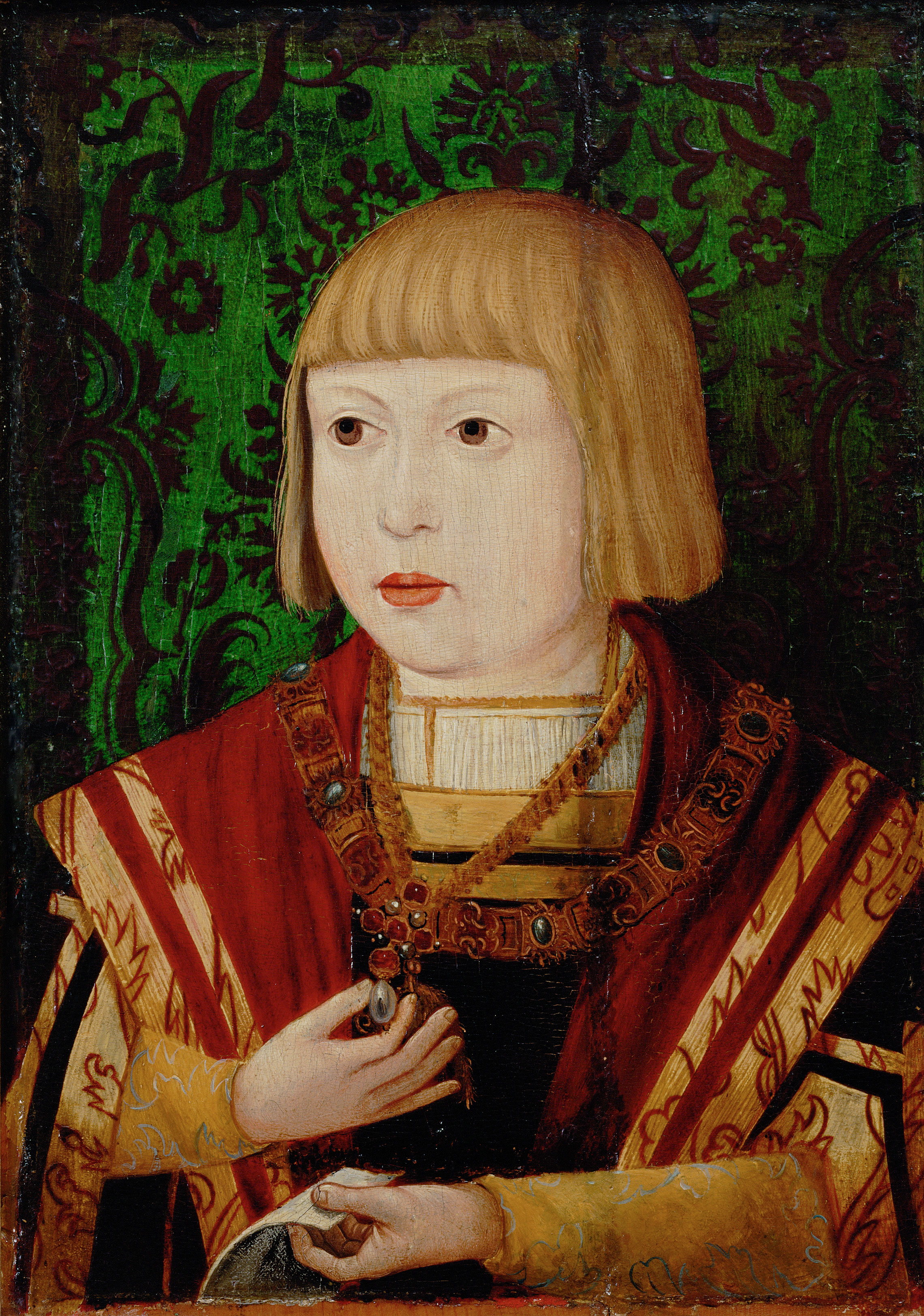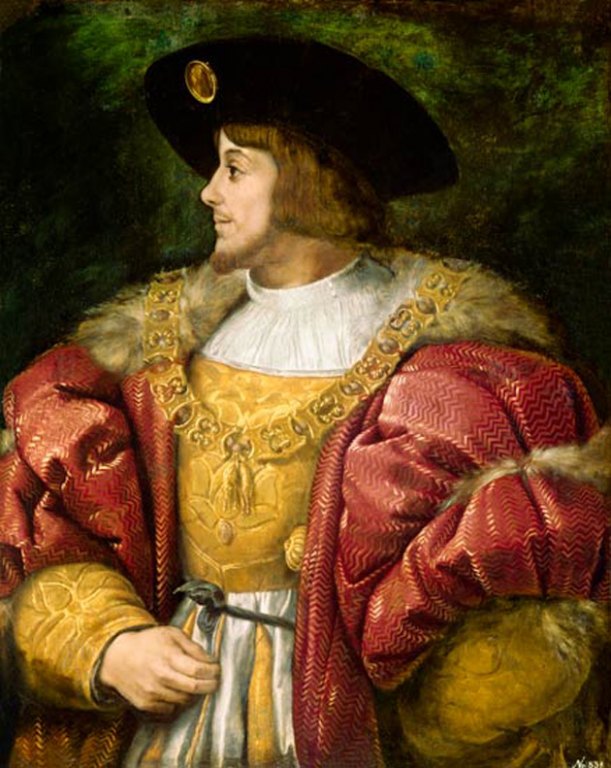|
Mary Of Austria (1505–1558)
Mary of Austria (15 September 1505 – 18 October 1558), also known as Mary of Hungary, was Queen of Hungary and Bohemia as the wife of King Louis II, and was later governor of the Habsburg Netherlands. The daughter of Queen Joanna and King Philip I of Castile, Mary married King Louis II of Hungary and Bohemia in 1515. Their marriage was happy but short and childless. Upon her husband's death following the Battle of Mohács in 1526, Queen Mary governed Hungary as regent in the name of the new king, her brother, Ferdinand I. Following the death of their aunt Margaret in 1530, Mary was asked by her eldest brother, Charles V, Holy Roman Emperor, to assume the governance of the Netherlands and guardianship over their nieces, Dorothea and Christina of Denmark. As governor of the Netherlands, Mary faced riots and a difficult relationship with the Emperor. Throughout her tenure she continuously attempted to ensure peace between the Emperor and the King of France. Although she neve ... [...More Info...] [...Related Items...] OR: [Wikipedia] [Google] [Baidu] |
Queen Consort Of Hungary
This is a list of the queens consorts of Hungary (), the consorts of the King of Hungary, kings of Hungary. After the extinction of the Árpád dynasty and later the Capetian House of Anjou, Angevin dynasty, the title of King of Hungary has been held by a monarch outside of Hungary with a few exceptions. After 1526, the title of Queen of Hungary belonged to the wife of the Habsburg monarchy, Habsburg Emperors who were also King of Hungary. Queens of Hungary also held the titles after 1526: Holy Roman Empress (later Empress of Austria) and List of Bohemian consorts, Queen consort of Bohemia. Since Leopold I, Holy Roman Emperor, Leopold I, all kings of Hungary used the title of Apostolic King of Hungary the title given to Stephen I of Hungary, Saint Stephen I by the Pope and their wives were styled as Apostolic Queens of Hungary. The title lasted just a little over nine centuries, from 1000 to 1918. The Kingdom of Hungary also had two queen regnant, queens regnant (''királynő'') ... [...More Info...] [...Related Items...] OR: [Wikipedia] [Google] [Baidu] |
List Of Hungarian Consorts
This is a list of the queens consorts of Hungary (), the consorts of the kings of Hungary. After the extinction of the Árpád dynasty and later the Angevin dynasty, the title of King of Hungary has been held by a monarch outside of Hungary with a few exceptions. After 1526, the title of Queen of Hungary belonged to the wife of the Habsburg Emperors who were also King of Hungary. Queens of Hungary also held the titles after 1526: Holy Roman Empress (later Empress of Austria) and Queen consort of Bohemia. Since Leopold I, all kings of Hungary used the title of Apostolic King of Hungary the title given to Saint Stephen I by the Pope and their wives were styled as Apostolic Queens of Hungary. The title lasted just a little over nine centuries, from 1000 to 1918. The Kingdom of Hungary also had two queens regnant (''királynő'') who were crowned as kings: Maria I and Maria II Theresa. Grand Princesses of the Hungarians Queens consort of Hungary House of Árp� ... [...More Info...] [...Related Items...] OR: [Wikipedia] [Google] [Baidu] |
Maximilian Of Burgundy
Maximilian of Burgundy (1514–1558), marquis of Veere and Lord of Beveren, was a noble from the Low Countries in the service of the Habsburgs. Family Maximilian was the son of Adolf of Burgundy and Anna of Bergen. He was a descendant of Antoine, bastard of Burgundy, illegitimate son of Philip the Good. The marquis of Veere resided at Zandenburg. Life Desiderius Erasmus was a regular visitor at Maximilian's father's house and Erasmus wrote the young Maximilian letters to encourage him to study science. In 1540 Maximilian succeeded his father as admiral of the Netherlands. In 1542 he became admiral of Flanders and in 1546 Knight in the Order of the Golden Fleece The Distinguished Order of the Golden Fleece (, ) is a Catholic order of chivalry founded in 1430 in Brugge by Philip the Good, Duke of Burgundy, to celebrate his marriage to Isabella of Portugal, Duchess of Burgundy, Isabella of Portugal. T .... In 1547 he became Stadtholder of Holland, Zeeland an ... [...More Info...] [...Related Items...] OR: [Wikipedia] [Google] [Baidu] |
Kingdom Of France
The Kingdom of France is the historiographical name or umbrella term given to various political entities of France in the Middle Ages, medieval and Early modern France, early modern period. It was one of the most powerful states in Europe from the High Middle Ages to 1848 during its dissolution. It was also an early French colonial empire, colonial power, with colonies in Asia and Africa, and the largest being New France in North America geographically centred around the Great Lakes. The Kingdom of France was descended directly from the West Francia, western Frankish realm of the Carolingian Empire, which was ceded to Charles the Bald with the Treaty of Verdun (843). A branch of the Carolingian dynasty continued to rule until 987, when Hugh Capet was elected king and founded the Capetian dynasty. The territory remained known as ''Francia'' and its ruler as ('king of the Franks') well into the High Middle Ages. The first king calling himself ('King of France') was Philip II of Fr ... [...More Info...] [...Related Items...] OR: [Wikipedia] [Google] [Baidu] |
Christina Of Denmark
Christina of Denmark (; November 1521 – 10 December 1590) was a Denmark, Danish princess, the younger surviving daughter of Christian II, King Christian II of Denmark and Norway and Isabella of Austria. By her two marriages, she became List of Milanese consorts, Duchess of Milan, then List of Lorrainian royal consorts, Duchess of Lorraine. She served as the regent of Lorraine from 1545 to 1552 during the minority of her son. She was also a claimant to the thrones of Denmark, Norway and Sweden in 1561–1590 and was sovereign Lady of Tortona in 1578–1584. Early life Christina was born in Nyborg in central Denmark in 1521 to King Christian II of Denmark, Christian II of Denmark, Sweden, and Norway and his wife Isabella of Austria, the third child of Philip I of Castile, Duke Philip of Burgundy and Queen Joanna of Castile. In January 1523, nobles rebelled against her father and offered the throne to his uncle, Duke Frederick I of Denmark, Frederick of Holstein. Christina and ... [...More Info...] [...Related Items...] OR: [Wikipedia] [Google] [Baidu] |
Dorothea Of Denmark, Electress Palatine
Dorothea of Denmark and Norway (10 November 1520 – 31 May 1580) was a Danish, Norwegian and Swedish princess and an electress of the Palatinate as the wife of Elector Frederick II of the Palatinate. She was a claimant to the Danish, Norwegian and Swedish thrones and titular monarch in 1559–1561. Biography Princess Dorothea was born on 10 November 1520 as the fourth child and eldest daughter born to King Christian II of Denmark and Norway and Isabella of Austria, sister of Holy Roman Emperor Charles V. Dorothea had an elder brother, Johann "Hans", born 21 February 1518. Her elder twin brothers, Philip Ferdinand and Maximilian, born 4 July 1519, had both died before her birth, the latter in 1519 and the former in 1520. Her sister Christina of Denmark, Christina was born two years later, in November 1521, and was her only sibling to reach adulthood. Christina would marry twice, first to Francesco II Sforza, Francis II, Duke of Milan, and secondly to Francis I, Duke of Lorrain ... [...More Info...] [...Related Items...] OR: [Wikipedia] [Google] [Baidu] |
Ferdinand I, Holy Roman Emperor
Ferdinand I (10 March 1503 – 25 July 1564) was Holy Roman Emperor from 1556, King of Bohemia, King of Hungary, Hungary, and List of rulers of Croatia, Croatia from 1526, and Archduke of Austria from 1521 until his death in 1564.Milan Kruhek: Cetin, grad izbornog sabora Kraljevine Hrvatske 1527, Karlovačka Županija, 1997, Karslovac Before his accession as emperor, he ruled the Erblande, Austrian hereditary lands of the House of Habsburg in the name of his elder brother, Charles V, Holy Roman Emperor. Also, he often served as Charles' representative in the Holy Roman Empire and developed encouraging relationships with German princes. In addition, Ferdinand also developed valuable relationships with the German banking house of Jakob Fugger and the Catalan bank, Banca Palenzuela Levi Kahana. The key events during his reign were the conflict with the Ottoman Empire, which in the 1520s began a great advance into Central Europe, and the Protestant Reformation, which resulted in s ... [...More Info...] [...Related Items...] OR: [Wikipedia] [Google] [Baidu] |
Regent
In a monarchy, a regent () is a person appointed to govern a state because the actual monarch is a minor, absent, incapacitated or unable to discharge their powers and duties, or the throne is vacant and a new monarch has not yet been determined. The rule of a regent or regents is called a regency. A regent or regency council may be formed ''ad hoc'' or in accordance with a constitutional rule. ''Regent'' is sometimes a formal title granted to a monarch's most trusted advisor or personal assistant. If the regent is holding the position due to their being in the line of succession, the compound term '' prince regent'' is often used; if the regent of a minor is their mother, and she is wife or widow of the king, she would be referred to as ''queen regent''. If the formally appointed regent is unavailable or cannot serve on a temporary basis, a may be appointed to fill the gap. In a monarchy, a regent usually governs due to one of these reasons, but may also be elected to ... [...More Info...] [...Related Items...] OR: [Wikipedia] [Google] [Baidu] |
Battle Of Mohács
The Battle of Mohács (; , ) took place on 29 August 1526 near Mohács, in the Kingdom of Hungary. It was fought between the forces of Hungary, led by King Louis II of Hungary, Louis II, and the invading Ottoman Empire, commanded by Suleiman the Magnificent and his grand vizier, Pargalı Ibrahim Pasha. The Ottomans achieved a decisive victory through superior planning, firepower, and a well-executed encirclement that overwhelmed the Hungarian forces. The Hungarian army, encouraged by the nobility to engage prematurely, launched a frontal assault that collapsed under coordinated Ottoman counterattacks. King Louis and much of the Hungarian aristocracy were killed, resulting in the destruction of the royal army and the end of the Jagiellonian dynasty in Hungary and Bohemia. The aftermath saw the partition of Hungary between the Ottoman Empire, the Habsburg monarchy, and the Eastern Hungarian Kingdom. The battle marked the beginning of sustained Ottoman–Habsburg wars and the ... [...More Info...] [...Related Items...] OR: [Wikipedia] [Google] [Baidu] |
Kingdom Of Bohemia
The Kingdom of Bohemia (), sometimes referenced in English literature as the Czech Kingdom, was a History of the Czech lands in the High Middle Ages, medieval and History of the Czech lands, early modern monarchy in Central Europe. It was the predecessor state of the modern Czech Republic. The Kingdom of Bohemia was an Imperial State in the Holy Roman Empire. The List of Bohemian monarchs, Bohemian king was a prince-elector of the empire. The kings of Bohemia, besides the region of Bohemia itself, also ruled other Lands of the Bohemian Crown, lands belonging to the Bohemian Crown, which at various times included Moravia, Silesia, Lusatia, and parts of Saxony, Brandenburg, and Bavaria. The kingdom was established by the Přemyslid dynasty in the 12th century by the Duchy of Bohemia, later ruled by the House of Luxembourg, the Jagiellonian dynasty, and from 1526 the House of Habsburg and its successor, the House of Habsburg-Lorraine. Numerous kings of Bohemia were also elected Hol ... [...More Info...] [...Related Items...] OR: [Wikipedia] [Google] [Baidu] |
Kingdom Of Hungary
The Kingdom of Hungary was a monarchy in Central Europe that existed for nearly a millennium, from 1000 to 1946 and was a key part of the Habsburg monarchy from 1526-1918. The Principality of Hungary emerged as a Christian kingdom upon the Coronation of the Hungarian monarch, coronation of the first king Stephen I of Hungary, Stephen I at Esztergom around the year 1000;Kristó Gyula – Barta János – Gergely Jenő: Magyarország története előidőktől 2000-ig (History of Hungary from the prehistory to 2000), Pannonica Kiadó, Budapest, 2002, , pp. 37, 113, 678 ("Magyarország a 12. század második felére jelentős európai tényezővé, középhatalommá vált."/"By the 12th century Hungary became an important European factor, became a middle power.", "A Nyugat részévé vált Magyarország.../Hungary became part of the West"), pp. 616–644 his family (the Árpád dynasty) led the monarchy for 300 years. By the 12th century, the kingdom became a European power. Du ... [...More Info...] [...Related Items...] OR: [Wikipedia] [Google] [Baidu] |
Philip I Of Castile
Philip the Handsome (22 June/July 1478 – 25 September 1506), also called the Fair, was ruler of the Burgundian Netherlands and titular Duke of Burgundy from 1482 to 1506, as well as the first Habsburg King of Castile (as Philip I) for a brief time in 1506. The son of Maximilian of Austria (later Holy Roman Emperor as Maximilian I) and Mary of Burgundy, Philip was not yet four years old when his mother died as a result of a riding accident, and upon her death, he inherited the Burgundian Netherlands. Despite his young age, Philip quickly proved himself an effective ruler beloved by his people in the Low Countries, pursuing policies that favored peace and economic development, while maintaining a steady course of the government building. In 1496, Philip's father arranged for him to marry Joanna, the second daughter of Queen Isabella I of Castile and King Ferdinand II of Aragon. Around the same time, Philip's sister, Margaret, was given in marriage to Joanna's brother John, ... [...More Info...] [...Related Items...] OR: [Wikipedia] [Google] [Baidu] |








